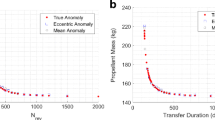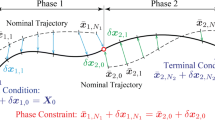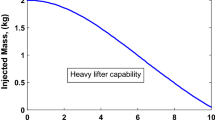Abstract
To expand mission capabilities needed without a proportional increase in cost or risk for exploration of the solar system, the multiple objective trajectory using low-thrust propulsion and gravity-assist technique is considered. However, low-thrust, gravity-assist trajectories pose significant optimization challenges because of their large design space. Here, the planets are selected as primal scientific mission goals, while the asteroids are selected as secondary scientific mission goals, and a global trajectory optimization problem is introduced and formulated. This multi-objective decision making process is transformed into a bi-level programming problem, where the targets like planets with small subsamples but high weight are optimized in up level, and targets like asteroids with large subsamples but low weight are optimized in down level. Then, the selected solutions for bi-level programming are optimized thanks to a cooperative Differential Evolution (DE) algorithm that is developed from the original DE algorithm; in addition, an sequential quadratic programming (SQP) method is used in low-thrust optimization. This solution approach is successfully applied to the simulation case of the multi-objective trajectory design problem. The results obtained are presented and discussed.
Similar content being viewed by others
References
Williams S N, Coverstone-Carroll V. Benefits of solar electric propulsion for the next generation of planetary exploration missions. J Astronaut Sci, 1997, 45(2): 143–159
Evans B, Harland D M. NASA’s Voyager Missions: Exploring the Outer Solar System and Beyond. Berlin: Springer, 2004. 77–101
D’Amorio L A, Bright L E, Byrnes D V, et al. Galileo 1989 VEEGA mission description. In: AAS/AIAA Astrodynamics Conference. Stowe: AAS, 1989. 1–3
Peralta F, Flanagan S. Cassini interplanetary trajectory design. Control Eng Practice, 1995, 3(11): 1603–1610
Petropoulos A E, Longuski J M. Shape-based algorthm for automated design of low-thrust, gravity-assist trajectores. J Spacecraft and Rockets, 2004, 41(5): 787–796
Guo T D, Jiang F H, Baoyin H X, et al. Fuel optimal low thrust rendezvous with outer planets via gravity assist. Sci China Phys, Mech & Astron, 2011, 54(4): 756–769
Wuerl A, Crain T, Brasden E. Genetic algorithm and calculus of variantions-based trajectory optimization technique. J Spacecraft and Rockects, 2003, 40(6): 882–888
Woo B, Coverstone V L, Cupples M. Low-thrust trajectory optmization procedure for gravity-assist, outer planet missions. J Spacecraft and Rockets, 2006, 43(1): 121–129
Vavrian M A, Howell K C. Global low-thrust trajectory optimization through hybridization of a genetic algorithm and a direct method. In: AIAA/AAS Astrodynamisc Specialist Conference. Honolulu: AIAA, 2004. 10–17
Dachwald B. Evolutionary neurocontrol: a smart method for global optmization of low-thrust trajectories. In: AIAA/AAS Astrodynamisc Specialist Conference. Rhode Island: AIAA, 2004. 1–16
Perret A, Bernard J, Vutien K, et al. Multiple asteroids fly-bys mission a systermatic search for trajectories. In: 33rd International Astronautical Congress. Paris: IAF, 1982. 1–5
Bender D, Friedlander A. Multiple asteroid rendezvous missions. In: AAS/AIAA Astrodynamics Specialist Conference. Provincetown: AAS, 1979. 1–8
Morimato M, Yamakawa H, Yoshikawa M, et al. Trajectory design of multiple asteroid sample return mission. Adv Space Res, 2004, 34(11): 2281–2285
http://cct.cnes.fr/cct02/gtoc4/infos/gtoc4_problem_description.pdf
Grigoriev I, Zapletin M. http://mech.math.msu.su/gtoc5/gtoc5 problem description. pdf
Vasile M, De Pascale P. Preliminaty design in multiple gravity-assist trajectories. J Spacecraft and Rockets, 2006, 43(4): 794–805
Vinko T, Izzo D, Bombardelli, C. Benchmarking different global optimization techniques for preliminary space trajectory design. In: 58th International Astronautical Congress. Hyderabad: IAF, 2007. 1–9
Izzo D. Advances in global optimization for space trajectory design. In: 25th International Symposium on Space Technology and Science. Japan, 2006. 2–6
Vallado D A. Fundamentals of Astrodynamis and Applications. El Segundo: Microcosm Press, 2004. 448
Betts J T. Practical Methods for Optimal Control Using Nonlinear Programming. Philadelphia: Society for Industrial and Applied Mathematics, 2001. 94
Stron R, Price K. Diffrential Evolution—A simple and efficient heuristic for global optimization over continuous spaces. J Global Optm, 1997, 11: 341–359
Storn R. On the Usage of differential evolution for function optimization. In: Biennial Conference. Berkeley: North American Fuzzy Information Processing Society, 1996. 519–523
Sentinella M R, Casalino L. Cooperative evolutionary algorithm for space trajectory optimization. Celest Mech Dyn Astr, 2009, 105: 211–227
Author information
Authors and Affiliations
Corresponding author
Rights and permissions
About this article
Cite this article
Shen, H., Zhou, J., Peng, Q. et al. Multi-objective interplanetary trajectory optimization combining low-thrust propulsion and gravity-assist maneuvers. Sci. China Technol. Sci. 55, 841–847 (2012). https://doi.org/10.1007/s11431-011-4705-5
Received:
Accepted:
Published:
Issue Date:
DOI: https://doi.org/10.1007/s11431-011-4705-5




